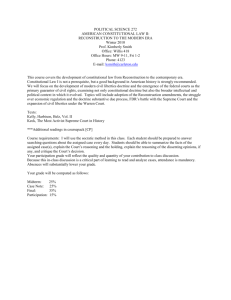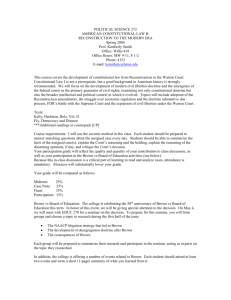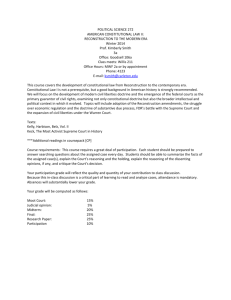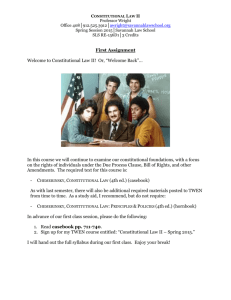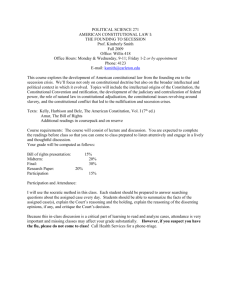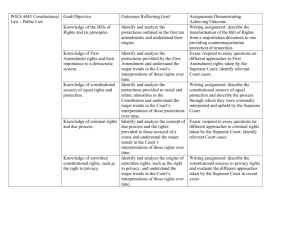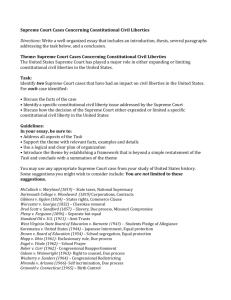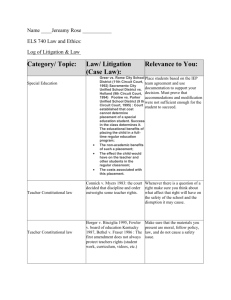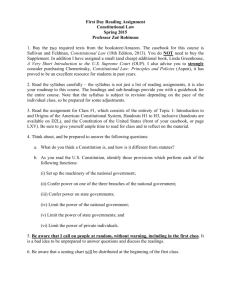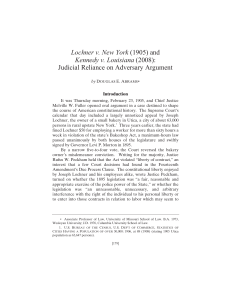Winter
advertisement
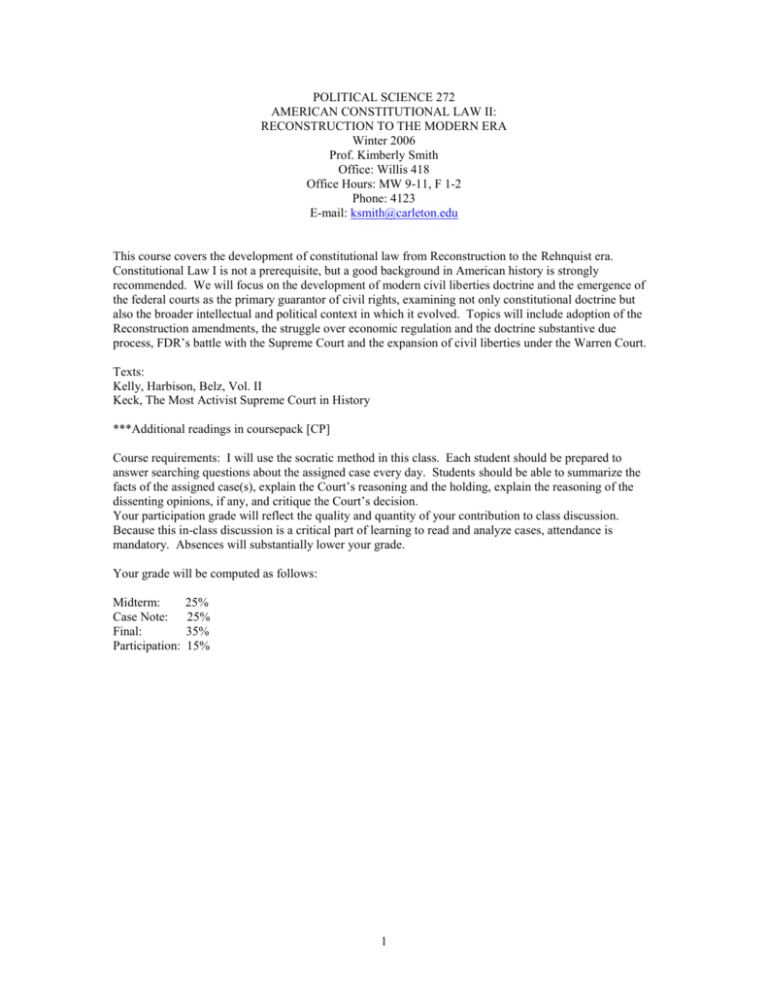
POLITICAL SCIENCE 272 AMERICAN CONSTITUTIONAL LAW II: RECONSTRUCTION TO THE MODERN ERA Winter 2006 Prof. Kimberly Smith Office: Willis 418 Office Hours: MW 9-11, F 1-2 Phone: 4123 E-mail: ksmith@carleton.edu This course covers the development of constitutional law from Reconstruction to the Rehnquist era. Constitutional Law I is not a prerequisite, but a good background in American history is strongly recommended. We will focus on the development of modern civil liberties doctrine and the emergence of the federal courts as the primary guarantor of civil rights, examining not only constitutional doctrine but also the broader intellectual and political context in which it evolved. Topics will include adoption of the Reconstruction amendments, the struggle over economic regulation and the doctrine substantive due process, FDR’s battle with the Supreme Court and the expansion of civil liberties under the Warren Court. Texts: Kelly, Harbison, Belz, Vol. II Keck, The Most Activist Supreme Court in History ***Additional readings in coursepack [CP] Course requirements: I will use the socratic method in this class. Each student should be prepared to answer searching questions about the assigned case every day. Students should be able to summarize the facts of the assigned case(s), explain the Court’s reasoning and the holding, explain the reasoning of the dissenting opinions, if any, and critique the Court’s decision. Your participation grade will reflect the quality and quantity of your contribution to class discussion. Because this in-class discussion is a critical part of learning to read and analyze cases, attendance is mandatory. Absences will substantially lower your grade. Your grade will be computed as follows: Midterm: Case Note: Final: Participation: 25% 25% 35% 15% 1 Research Paper: Case Note Your assignment is to research a significant constitutional case and explain why it’s important to the development of constitutional law, to constitutional politics, and to the development of the Court as a political institution. Your paper should be no more than 15 pages (12-pt font, 1 inch margins). Case notes are designed to explain the facts, reasoning and holding in a case in a concise and simple fashion. They are usually read by legal professionals, but they should be easily understood by an intelligent layperson. They follow a standard format: I. II. III. IV. V. Introduction: This should be brief and to the point. It should state your thesis. Background: This section will discuss the specific facts of the case as well as any political, social, legal, or cultural contextual factors that you think will help to illuminate the case. It should conclude by telling us how the case got to the Supreme Court and what the major legal issues were. Analysis of the Decision: This section will take us carefully, in a step-by-step analysis, through the reasoning in the Court’s opinion and the concurring and dissenting opinions. You may ignore or only touch on the minor or technical issues; focus on the important ones. Significance: This section should discuss the important impacts of the decision, which may be social, economic, political or legal. Your research should alert you to a range of important consequences; this section should demonstrate your deep engagement with the scholarly literature. Conclusion: A separate conclusion is optional. You will turn in sections of the case note for me to comment on as indicated on the syllabus. You will then revise these sections and turn in a complete, polished case note on March 10, by 5 pm. Documenting sources: I expect you to do a significant amount of research on your case. A thoroughly researched paper will rely on many sources, drawing on both books and periodicals. Your bibliography should demonstrate that you’ve explored the best scholarship on the subject (which will typically mean that you should not rely on Internet sources, unless you can make the case that it’s reliable and respected.) You should cite your sources; the conventions of legal scholarship demand that you carefully document your factual assertions. The following are recommended cases. You can choose a case not on this list; just clear it with me first: The Slaughterhouse Cases, 83 US 36 (1873) [equal protection] The Civil Rights Cases, 109 US 3 (1883) [equal protection] Lochner v New York, 198 US 45 (1905) [econ regulation] Munn v Illinois, 94 US 113 (1877) [labor] Muller v Oregon, 208 US 412 (1908) [labor] West Coast Hotel v Parrish, 300 US 379 (1937) [labor] Palko v Connecticut, 302 US 219 (1937) [due process] West Virginia State Board of Education v Barnette, 319 US 624 (1943) [church & state] Mapp v Ohio, 367 US 643 (1961) [rights of accused] Griswold v Connecticut, 381 US 479 (1965) [privacy rights] Brandenburg v Ohio, 395 US 444 (1969) [free speech] US v O’Brien, 391 US 367 (1968) [free speech] Miranda v Arizona, 384 US 436 (1966) [rights of accused] Roe v Wade, 410 US 113 (1973) [abortion rights] Regents of the Univ. of California v Bakke, 438 US 265 (1978) [aff. action] Romer v Evans 517 US 620 (1996) [gay rights] Lawrence v Texas, 539 US 558 (2003) Nollan v California Coastal Commission, 483 US 825 (1987) [takings; env’tal regulation] McClesky v Kemp, 481 US 279 (1987) [capital punishment] Atkins v Virginia, 536 US 304 (2002) [capital punishment] 2 I. Introduction Class 1: Introduction Class 2: The Supreme Court and Individual Rights Marbury v Madison Barron v Baltimore KHB Ch. 17 II. Reconstruction & the Nationalization of the Bill of Rights Class 3: Incorporation controversy Douglas’ Appendix to Adamson v California Civil Right Bill of 1866 13th, 14th, 15th amendments Corfield v Coryell Class 4: Due Process Hurtado v California Palko v Connecticut Rochin v California *Topic of case note and preliminary bibliography due *Optional extra class: introduction to legal research (to be scheduled) III. Race and citizenship Class 5: Slaughterhouse Cases KHB Ch. 18 Class 6: Civil Rights Cases Class 7: Plessy v Ferguson IV. The “Lochner Era” Class 8: Munn v Illinois KHB 19, 20 Class 9: Lochner v New York KHB Ch. 23 *Background section of case note due, properly documented Class 10: Muller v Oregon Class 11: Adkins v Childrens Hospital West Coast Hotel v Parrish Carolene Products footnote 4 KHB Ch. 24, 25 Class 12: MIDTERM EXAM V. The Warren Court 3 Class 13: Brown v Board of Education KHB Ch. 29 Class 14: Heart of Atlanta Motel v US, Katzenbach v McClung US v Morrison Class 15: The Warren Court and Civil Rights KHB Ch. 30 Class 16: Keck ch 2, 3 *Analysis and revised background sections of case note due, both sections properly documented VI. The Burger/Rehnquist Era: Activism or Restraint? Class 17: Death Penalty KHB Ch. 33 Furman v Georgia Class 18: Right to Privacy Griswold v Connecticut, Roe v Wade, Casey v Akron Class 19: Gay rights Bowers v Hardwick, Lawrence v Texas, Goodridge v Dept. of Public Health (Mass 2003) Class 20: Religion: Free exercise Oregon v Smith Boerne v Flores Class 21: Equal Protection US v Virginia Grutter v Bollinger Class 22: Keck, Ch. 4, 5 Class 23: Keck, Ch. 6, 7 Class 24: Thomas Keck visits Keck, Conclusion *Evening session: Keck presentation VI. The Roberts Court? Class 25: Roberts confirmation materials Class 26: Continued Class 27: Conclusion/Review Class 28: No class *Final draft of case note due in my office by 5 pm Final Exam: Tues, Mar. 14, 8:30-11:00, or self-scheduled 4 Discussion Questions on Kelly, Harbison and Belz Ch. 17: What were the chief issues raised by the adoption of the Thirteenth and Fourteenth Amendments? Why did their opponents object to them? Ch. 18: Was Congressional reconstruction a success? What were its aims? What role did the Supreme Court play in the success or failure of reconstruction? Ch. 19: The authors say on p. 363 that during the transition to industrialism, “serious internal contradictions resulted which transgressed the spirit of American constitutionalism.” What were those contradictions? Ch. 20: This chapter describes a Court that grew more conservative in the 1880s and1890s. What doctrines did it develop to restrict government power to regulate and to support laissez-faire capitalism? How did these doctrines affect federal-state relations? Ch. 23: This chapter discusses the Court’s activities in supporting and limiting government regulation during the period from 1900 to 1933. Did the Court exceed its constitutional authority? Was it more active in the policy process than it should have been, under our constitutional system? Ch. 24, 25: The text describes a massive expansion of federal power and transfer of power from the legislative to the executive branch during the New Deal. Did these developments undermine the constitutional principles of limited government, separation of powers and federalism? Should the Court have stood up to Roosevelt, or were the judges right to (eventually) acquiesce in this new constitutional order? (Recall the argument in Ch. 26 that this expansion of federal power was accompanied by and facilitated the expansion of civil liberty). Ch. 29: Does this chapter support or undermine the view that the Supreme Court played an important role in achieving greater racial equality in American society? Did the Supreme Court have a significant influence on either state action or private discriminatory practices? Ch. 30: Do the authors approve of the Warren Court’s transformation of New Deal liberalism into “a public policy of egalitarianism”? Do you? Did the Court exceed its constitutional role, or were the doctrines discussed in this chapter legitimate attempts to realize constitutional values? 5
